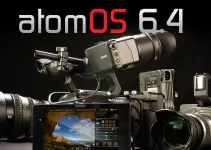The latest few generations of chips released from both Intel and AMD have brought unprecedented amounts of raw power in all computers: laptop and workstation alike have reached tremendous amounts of editing capabilities. Just a few years back we would’ve laughed at the thought of an editor cutting H.264 4K files on the go, 8 or 10bit it would not matter, it was just out of question.
Now, the dream has come true. If your software choice is MacOS, then there is only one choice: the MacBook Pro. The 15-inch model if you want to go for the stars. In Windows instead, we have a lot of options. One of the most favored is the XPS 15 by Dell.
A sleek and light laptop (not MacBook-esque-thin-and-light, but close) that is one of the most realistic alternatives to the MacBook Pro both in terms of power and portability. Max Yuryev is going to compare these two machines to gives a better idea of their performances as editing laptops.
The two rivals are both top of the line computers, there’s no doubt about that. Comparing the specs on paper, we can see a few similarities. They both come equipped with the latest i9 eight-core CPUs with a slight difference in clock speed, 32GB of RAM and ultra-fast NVME SSDs.
They differ instead in the graphic compartment: Dell has picked the GeForce 1650 4GB, while Apple, staying faithful to their choice of neglecting NVidia cards, has a Radeon Pro Vega 20 4GB card. The biggest difference, however, is the screen: we’re already familiar with Apple’s incredible quality of their Retina displays, but on the XPS we have a new option: a wonderful 4K OLED panel that may be the first of its kind on a laptop.
Even though we know that specs on paper, even if we may enjoy comparing them, they are not the whole story. It’s time to get the cat out of the bag and go run some benchmarks. Right off the bat, we get similar results, as expected, while comparing the CPUs in Geekbench.
They are, in fact, almost the same since the difference in clock speed is so small. What probably is making the real difference here is the better cooling the XPS has since Dell did compromise a little more on the laptop’s weight and footprint and thus has better results.
What you might not expect is the big difference we can see in the performance of the GPUs. Running the OpenCL test highlights a noticeable gap between the two cards.
The Radeon Pro 20 is after all one of the latest addition in the GPUs lineup offered by Apple, so we would have expected some heavier lifting, instead, the card seems to be no match to the power of CUDA cores.
But we know that while benchmarks are a good tool to take a rough measurement of the capabilities of a machine, dealing with real-world tasks is a whole different story, and that’s what Max have tested. One simple and boring task many editors will have to do is the stabilization of clips.
We can see that both laptops do quite a good job at that, while the real difference seems to be the NLE used. The ease that Final Cut has in destroying Resolve and Premiere’s performance is a testament to the great engineering that went inside the guts of the program itself.
Apple was not the only one to take the time to make optimizations. Even Adobe has finally surrendered and has been improving the usage of Metal, the set of APIs that Apple has released to MacOS developers. In the last few versions of Premiere Pro CC, there’s a significant improvement already. This is highlighted by the great performances of Premiere that we can see on macOS versus those in Windows even if it’s making do with a weaker GPU.
Since we’re talking GPUs here, there’s a valid point made by Max during this particular comparison. Both laptops come with almost the beefier CPU available out there. But when doing this kind of tests, the CPU rarely turns out to be the real bottleneck. We often see it seesawing back and forth between 30 and 50% of usage, while the GPUs are hovering in the 95-100% area.
It becomes clear that the real bottleneck in these laptops is the GPU. The quest for lighter and thinner devices is giving us laptops that struggle to unveil the full potential of the CPUs they come equipped with.
The MacBook makes a great leap when dealing in tasks where the T2 chip gets involved. This chip accelerates H.265 encoding, and in those exports, it becomes the key to the better export times across the board.
Interestingly in Resolve, there’s a huge difference when exporting 10-bit files. The XPS is incredibly faster (we’re talking 7 minutes against 37 minutes) but it could be a flaw in the test while rendering 10-bit, the matter needs to be investigated further.
You may be more interested in the performances in timeline usage since that’s what can make the difference between a full day of work and a frustrating and annoying unproductive day. Both the machines have solid performances handling compressed timelines, but they struggle on tougher codecs like the Canon C200 Raw files.
Premiere hits an all-time low of 11fps in playback, while Resolve and Final Cut get to something better. Reducing the resolution brings us quickly to a full playback.
If we need to draw some conclusions, there are a couple of warnings. The XPS has recently received a BIOS update that you should download straight away if you own the machine since it dramatically increases the overall performance. That said, the truth is that on the Windows side of the comparison, Max gets a little disappointed by the performances in the GPU department.
The amount of laptops available on the market is eroding the leadership the XPS used to have, and more and more laptops are besting it. Just think of the Nvidia certified Studio laptops: they all sport RTX cards. Each one of those will smoke out the GeForce 1650 in the blink of an eye.
Finally, we have to address the gorgeous screen on the XPS. The screen is beautiful, but you need to calibrate it often and most of all, you should set brightness and stick with that, since changing the value will result in a loss of color accuracy. That said, comparing the two laptops one will need to factor in different points of view.
It resembles quite well the whole Mac vs PC flame. The XPS is less expensive and upgradable, a feature we long lost on the Macs. In that regard, it gets better cooling, but the software is not so fine-tuned as MacOS can be. But you got to pay that fine-tuning, and the bill is going to be around a thousand bucks.
That makes the decision between the two systems almost philosophical: you can go the cheap but not-so-optimized way, or the beautiful sleek and tuned costly way. Either way, you get some, you lose some, what will you choose is really up to you.
[source: Max Yuryev]
Order Links:
Apple 15.4″ MacBook Pro with Touch Bar (Mid 2019, Space Gray) (B&H, Amazon)
Dell XPS 15 9570-8th Generation Intel Core i7-8750H Processor (B&H, Amazon)
Disclaimer: As an Amazon Associate partner and participant in B&H and Adorama Affiliate programmes, we earn a small comission from each purchase made through the affiliate links listed above at no additional cost to you.




